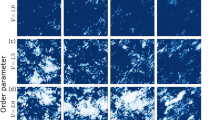Abstract
We investigate the effects of a finite electronic bandwidth in a disordered superconductor by considering the current tight binding Anderson model of disorder and a mean field BCS interaction. A general relation, between the transition temperatureT c and the disorder averaged spectral density associated with the electron propagator between neighboring lattice sites is found which enables us to predict superconductivity in the disorder induced localized state. A reasonable interpolation, between weak and strong disorder, is investigated and it predicts a maximum bandwidth where superconductivity is destroyed. In this case,T c as a function of the disorder is shown for a few values of the hopping constant. A brief discussion of the model validity range and its applications to disordered granular superconductors is presented.
Similar content being viewed by others
References
P. W. Anderson,J. Phys. Chem. Solids 11, 26 (1959).
This theorem has made possible the study of transport in dirty superconductors.
J. W. Rowell and R. C. Dynes (unpublished), Reproduced in ref. 4.
E. Abrahams, P. W. Anderson, D. C. Licciardello and T. V. Ramakkrishnam,Phys. Rev. Lett. 42, 673 (1979).
P. W. Anderson, K. A. Muttalib and T. V. Ramakkrishnam,Phys. Rev. B 28, 117 (1983).
M. Ma and P. A. Lee,Phys. Rev. B 32, 5658 (1985).
C. Wiecko and R. Allub,Phys. Rev. B 35, 2041 (1987).
P. W. Anderson,Phys. Rev. 109, 1492 (1958).
J. Bardeen, L. N. Cooper and J. R. Schrieffer,Phys. Rev. 108, 1175 (1957).
P. Lloyd,J. Phys. C 2, 1717 (1969).
See, for example, G. D. Mahan, Many particle Physics, Plenum Press, New York and London (1981).
D. J. Thouless,J. Phys. C 3, 1559 (1970).
R. J. Elliot, J. A. Krumhanal and P. Leath,Rev. Mod. Phys. 46, 465 (1974).
P. L. Leath,Phys. Rev. 171, 725 (1968).
See, for example, M. A. Abramowitz and I. A. Stegun, Handbook of mathematical functions, Dover INC, New York (1972).
R. Allub, A. Caro and C. Wiecko,Phys. Rev. B 36, 8823 (1987).
R. Allub, A. Caro and C. Wiecko,J. Low Temp. Phys. 75, 27 (1989).
R. Rangel. Talk at the workshop “Modern theory of solids”, Brasilia, International Center for Theoretical Physics, 1990.
B. I. Shklovskii and B. Z. Spivak. “Scattering and interference effects in variable range hopping conductance”. Hopping transport in solids. Ed. by M. Polak and B. Shklovskii, Elsevier Science publishers B. V. 1991.
Ernesto Medina and Merena Kardar.Phys. Rev. B 46, 9984 (1992-II).
R. Rangel and E. Medina. (unpublished).
Author information
Authors and Affiliations
Rights and permissions
About this article
Cite this article
Marín, F.P., Rangel, R. Superconductivity and random disorder in the narrow and wide band limit. J Low Temp Phys 92, 225–238 (1993). https://doi.org/10.1007/BF00682339
Received:
Revised:
Issue Date:
DOI: https://doi.org/10.1007/BF00682339




